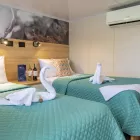Visit Tintoreras, located in the bay of Puerto Villamil. This small island, surrounded by calm, turquoise waters, has an easy trail with great landscapes and interesting fauna. Along the trail, see large numbers of Marine Iguanas basking in the sun, lava lizards, herons, gulls, and sea lions. In the coves, it is easy to find Sea Turtles, rays, and even penguins. Among the many inlets and channels on the coast, sometimes see White-tipped Reef Sharks (in Spanish "Tintoreras"). Following the excursion, return to the boat for breakfast and sail to your next destination.
Los Humedales is one of the Isabela Hidden Gems. "Humedales" translates to Wet Lands. This area, characterized by sandy beaches, rocky shores, and mangroves, has an extremely important role in the Galapagos as they provide a nursery for young marine animals and a nesting site for birds. Following the various paths, find a fabulous destination for bird lovers, pink flamingos, and migratory birds, including black-bellied and semipalmated plovers, whimbrel, osprey, greater and lesser yellowlegs, Wilson's phalarope, short-billed dowitcher, common tern, blue-winged teal, to name a few. You can also observe young giant tortoises from the Isabela Breeding Center.


















